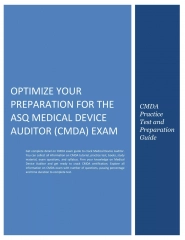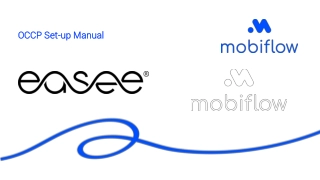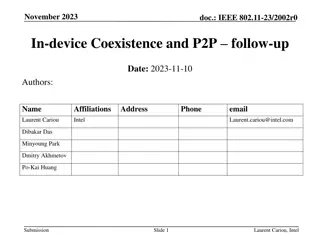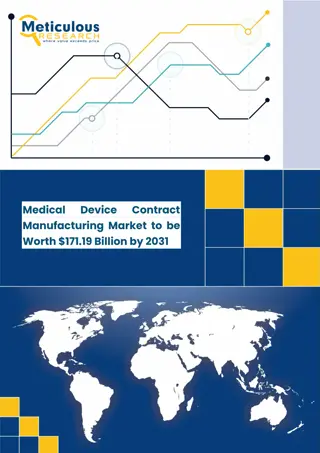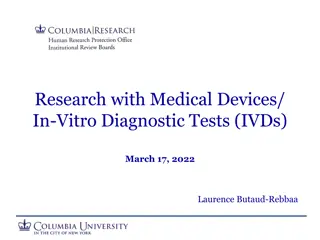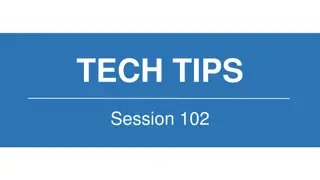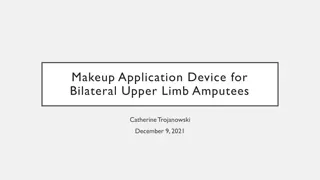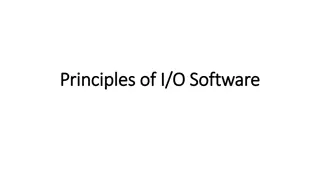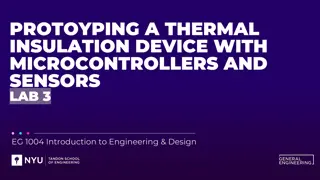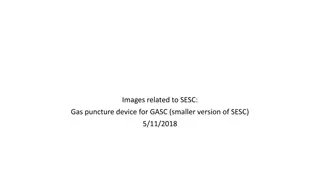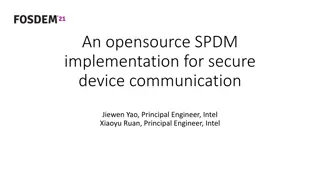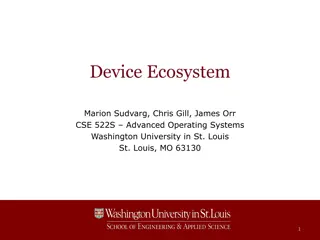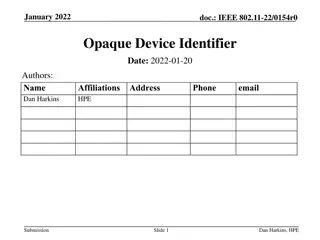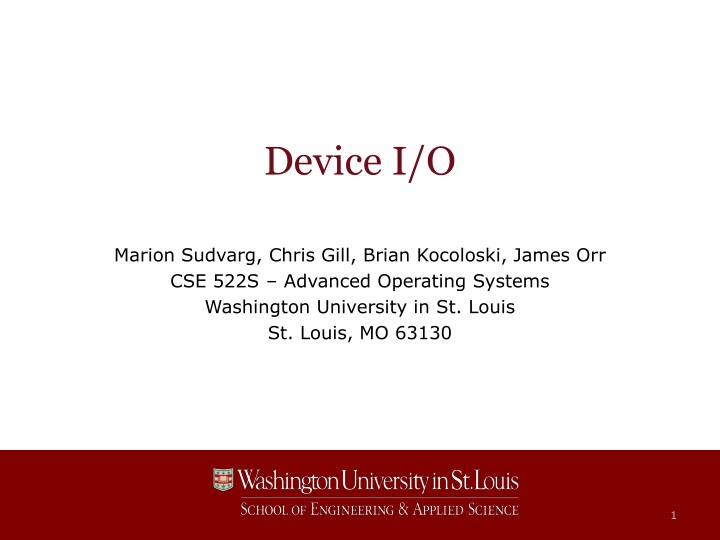
Device I/O in Advanced Operating Systems
Explore the intricacies of device I/O in advanced operating systems, including device interrupts, block I/O performance, device drivers, CPU access to memory, and I/O communication mechanisms facilitated by the kernel. Gain insights into the role of device drivers, DMA, and the interaction between the CPU and various I/O devices.
Download Presentation

Please find below an Image/Link to download the presentation.
The content on the website is provided AS IS for your information and personal use only. It may not be sold, licensed, or shared on other websites without obtaining consent from the author. If you encounter any issues during the download, it is possible that the publisher has removed the file from their server.
You are allowed to download the files provided on this website for personal or commercial use, subject to the condition that they are used lawfully. All files are the property of their respective owners.
The content on the website is provided AS IS for your information and personal use only. It may not be sold, licensed, or shared on other websites without obtaining consent from the author.
E N D
Presentation Transcript
Device I/O Marion Sudvarg, Chris Gill, Brian Kocoloski, James Orr CSE 522S Advanced Operating Systems Washington University in St. Louis St. Louis, MO 63130 1
So Far We ve discussed device interrupts Interrupt controller multiplexes IRQ signals Sends IRQ with line # to CPU We ve explored block I/O performance and control Block devices (e.g. hard drives) are slow compared to memory/CPU The kernel schedules reads from/writes to block devices to optimize performance (merging and sorting) I/O cgroups constrain the reads/writes CSE 522S Advanced Operating Systems 2
Today: Device I/O More detailed discussion of how the kernel enables I/O between CPU and devices Device drivers provide I/O mechanisms I/O is highly platform-dependent Kernel provides macros that wrap architecture- specific functionality Prerequisite to understanding I/O virtualization CSE 522S Advanced Operating Systems 3
Device Drivers Often implemented as kernel modules Linux driver philosophy: provide mechanism (What capabilities are provided?), not policy (How are these capabilities used?) Example: block device driver Mechanisms (handled by driver): Present the block device as a continuous array of data blocks Provide mechanisms to read from or write to these blocks Handle interrupts from the device Interpret interrupts and status messages Policy (not handled by driver): Partitions and filesystems Access control CSE 522S Advanced Operating Systems 4
Device Access The CPU accesses memory over the front-side bus through the Northbridge Many I/O devices are connected through the Southbridge, which communicates to the CPU through the Northbridge The southbridge provides multiplexing of interrupts and I/O communication to the CPU Communication with a device typically requires the CPU to transfer data from memory to the device over the bus (and bridge) Some devices (on Southbridge or Northbridge) can access memory directly, without the CPU. This is called Direct Memory Access (DMA) covered next time (Note: many modern processors integrate Northbridge functionality directly into CPU) CSE 522S Advanced Operating Systems 5
Device I/O Device I/O typically follows three patterns: Communication with device registers or pins (I/O ports) Access to device memory (e.g., memory on a graphics card, covered next time) Device access to main memory (DMA, covered next time) At the hardware level, device registers/pins are addressed similarly to device memory Some architectures address these exactly as memory addresses Other architectures (e.g., x86) use a different instruction to address I/O ports No conceptual difference Architecture-specific macros in the kernel provide a wrapper fa ade over the different instructions CSE 522S Advanced Operating Systems 6
Example: ISA Bus CPU Industry Standard Architecture (ISA) A 16-bit device bus on classic x86 PCs Now superseded by PCI, PCIe Allowed CPU/device communication over northbridge/southbridge Addressed directly by addresses 640KB to 1MB (0xA0000-0x100000) 0x200000 0x100000 RAM Northbridge Southbridge ISA CSE 522S Advanced Operating Systems 7
Example: Parallel Port Used to be on almost every PC and laptop! Most commonly used as a printer communication port Largely replaced by USB (and networked/Wi-Fi printers) Pins mapped to 3 8-bit I/O registers: R/W register for data transfer RO register for status WO control register Source: https://en.m.wikipedia.org/wiki/Parallel_port CSE 522S Advanced Operating Systems 8
Review: Kernel Virtual Memory Source: Linux Device Drivers (3rd Edition) Kernel manages physical memory Maintains its own page tables to enable a virtual address space Logical addresses directly map main memory Virtual addresses map main memory or device memory CSE 522S Advanced Operating Systems 9
Mapping Virtual Memory Recall: vmalloc allocates a contiguous region of virtual memory in the kernel Finds free physical pages of memory Modifies kernel page tables so they are logically contiguous For mapping I/O memory, use ioremap void * ioremap(phys_addr, size) Modifies page tables but does not allocate memory CSE 522S Advanced Operating Systems 10
Accessing I/O Memory ioremap returns a pointer to virtual address of mapped I/O Not portable to access memory directly via pointer! Instead, use special ioread/iowrite functions: unsigned int ioreadx(void * addr) void iowritex(ux value, void * addr) Note: replace x with register width (8, 16, 32, or 64 bits) You can also read/write a sequence of values to/from a register: ioreadx_rep(void * addr, void * buf, ulong count) iowritex_rep(void * addr, void * buf, ulong count) CSE 522S Advanced Operating Systems 11
Claiming I/O Registers I/O memory regions must be allocated previous to use This ensures that two drivers do not, e.g., handle the same device registers request_mem_region atomically checks if a memory region has already been claimed, then claims it for the driver release_mem_region releases the region (e.g., on driver unload) CSE 522S Advanced Operating Systems 12
Special Considerations Hardware registers are not memory! I/O operations have side effects Make sure the compiler writes back to memory (instead of keeping variables in CPU registers) Declare variables volatile Be careful to ensure the compiler does not reorder instructions Use compiler and hardware memory barriers (functions listed on pages 237-238 of LDD) CSE 522S Advanced Operating Systems 13
Todays Reading LDD Chapter 1, pages 1-4: A discussion of device drivers, and mechanism/policy split LDD Chapter 8, pages 224-226: Review of vmalloc and an introduction to ioremap LDD Chapter 9, pages 235-252: An overview of I/O communication Compiled into a single PDF on course website CSE 522S Advanced Operating Systems 14

